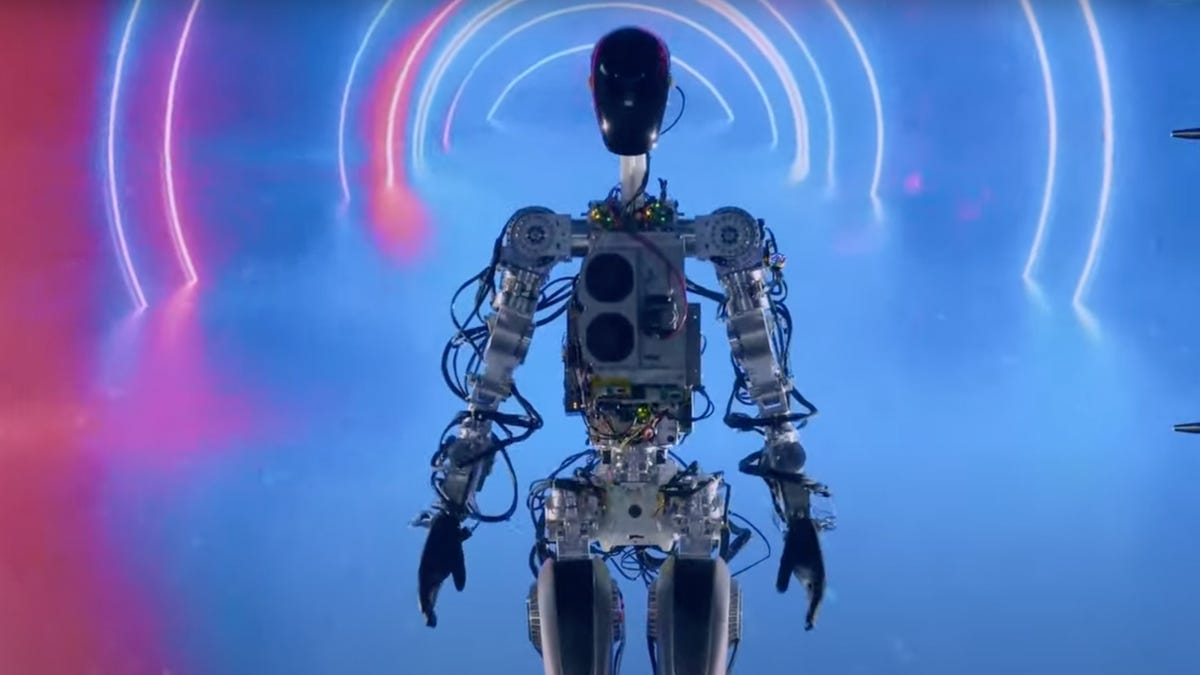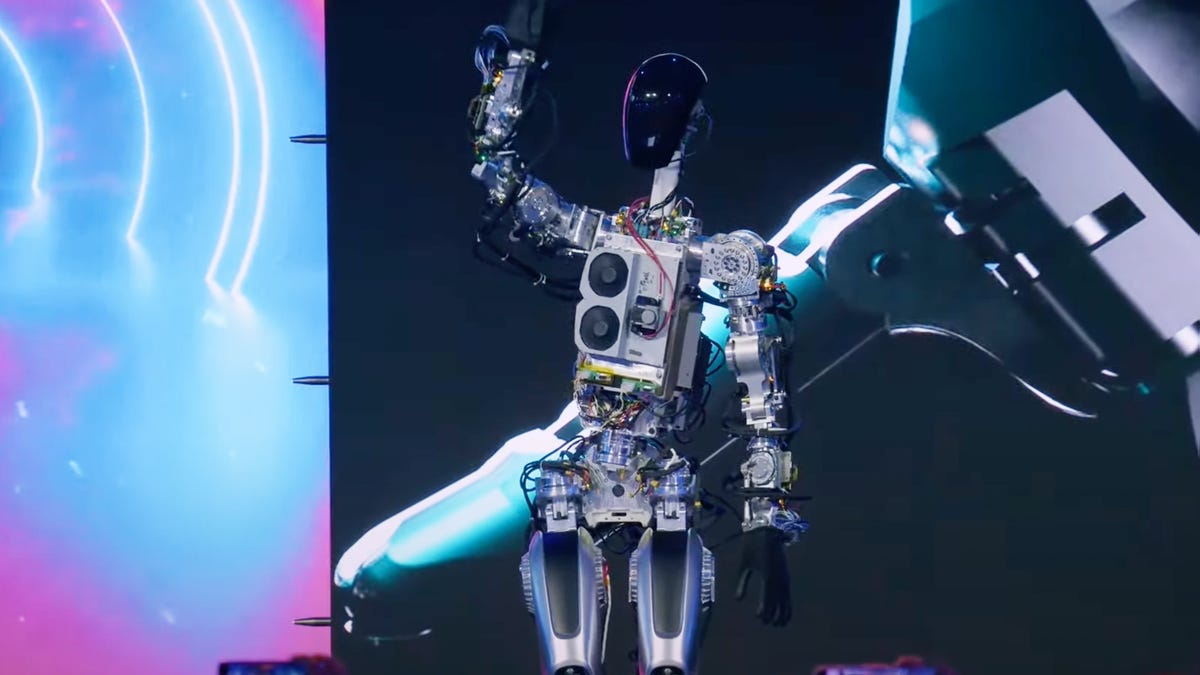Two prototype Tesla Bots could walk, wave their arms and grip with fingers. CEO Elon Musk says they’ll eventually cost $20,000 and should go on sale by 2027.

Tesla CEO Elon Musk on Friday unveiled the company’s Tesla Bot, a robot code-named Optimus that shuffled across a stage, waved, and pumped its arms in a low-speed dance move. The robot could cost $20,000 within three to five years, Musk said.
“Our goal is to make a useful humanoid robot as quickly as possible,” Musk said. It could eventually “help millions of people,” but the first uses will be in Tesla’s car factories, he said.
The robot wasn’t as flashy as some others, like Boston Dynamics’ parkour-capable Atlas, but it’s what Tesla put together in less than eight months. “The robot can do a lot more than what we showed you. We just didn’t want it to fall on its face,” Musk quipped at Tesla AI Day 2022, an event designed to showcase the robot and the company’s autonomous vehicle technology, called Full Self-Driving, or FSD.
Ultimately, Musk wants to build Tesla Bots by the millions, taking advantage of hardware, software, manufacturing and supply chain advantages developed for its car business. Take the company’s projections with a shakerful of salt, though. Tesla has succeeded as an automaker, leading the rest of the industry toward an electric vehicle future, but it’s missed many deadlines along the way.
The Optimus effort, while still early, is among the most ambitious in the robotics world given how widespread and capable Tesla hopes the robots can become. But progress is hard. Rivals like Boston Dynamics have worked for years on humanoid robots but so far have produced only prototypes. More common are robots with more limited abilities, like wheeled delivery bots or Amazon’s Astro, a household camera-equipped tablet on wheels.
Artificial intelligence technology works best with narrow jobs, but Tesla’s car piloting technology and robots must reckon with immense real-world variety. Optimus will likely lead a sheltered life to start. The company plans to use it first in Tesla’s own factories.
Jobs could include carrying parts to conventional robots on the manufacturing line, Musk said.
“The number of situations where Optimus is useful will grow exponentially,” Musk said. “Really, really fast.”

The first prototype of Optimus, the code name for the Tesla Bot, waves an arm at the Tesla AI Day 2022 event.
Two Tesla Bots on stage
Musk showed two robots. The first, walking model was built with off-the-shelf mechanical actuators, cylindrical devices that combine a motor with gearing and sensors. The second, whose limbs and fingers were controlled by Tesla’s own actuators, couldn’t walk and was wheeled out on stage. But its actuators let it lift its leg out to the side and grip with its hands. In a video, the bots could do more, including picking up boxes, holding a watering can for plants and turning at the waist.
“It wasn’t quite ready to walk, but I think it’ll walk in a few weeks,” Musk said of the second Optimus robot.
Tesla already had actuator engineers on staff for its vehicles. The strongest actuator, a linear model used in the Optimus leg, can hoist 1,000 pounds.
The second Optimus prototype weighs 161 pounds (73 kilograms). It uses a variation of the same computing hardware that powers Tesla’s FSD autonomous vehicle technology. Its battery pack has a capacity of 2.3 kilowatt hours, “perfect for a full day’s work,” one engineer said. It consumes about 100 watts of power sitting and 500 watts when walking briskly. That’s something like a high-end gaming PC.
The first robot walked at a slow, shuffling pace, with one foot placed just in front of the other. Its bent knees gave it a somewhat mincing gait, but that posture is common for robots since a straight-leg stance requires much more precise balance abilities. The robot was able to turn and flex at the waist. Its body was studded with mostly green LEDs, and its chest featured a large computer with dual spinning fans to cool the processors.
Tesla engineers emphasized the degrees of freedom in the Optimus robots — essentially the different ways it can bend or twist at different joints. The full robot body has more than 28 degrees of freedom, and each hand has 11, Tesla said.
For safety reasons, the robots will include an external mechanism so people can stop them, Musk said, and that override mechanism won’t be updatable over the internet. In the longer run, for safety reasons, the robots likely will be “governed by some laws of robotics that you cannot overcome, like not doing harm to others,” Musk said, a reference to the three laws of robotics from science fiction author Isaac Asimov.
Tesla uses the same AI software to control the Tesla Bot as it uses in its cars. Some of the same technology applies, like gauging “occupancy” of nearby areas. It’s just trained with real-world environments instead of driving video, Tesla said.
Musk didn’t hold back on the sci-fi promises for Tesla’s robots. With robots at work, economics enters a new age, a “future of abundance, a future where there is no poverty, a future where you can have whatever you want in terms of products and services,” Musk said. “It really is a fundamental transformation of civilization as we know it.”





